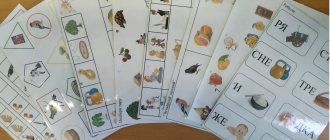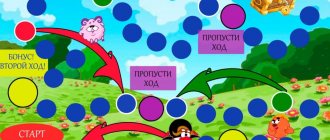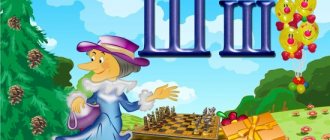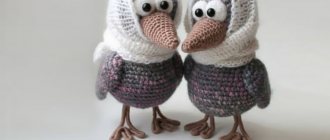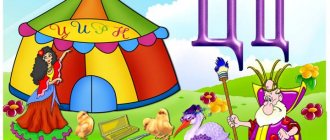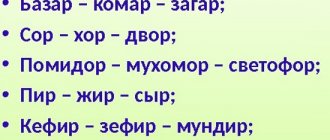We begin automating sounds in words only after the child clearly pronounces an isolated sound and can pronounce it correctly in syllables. We name words, highlighting the automated sound with our voice. We pronounce the words slowly, pronouncing them clearly. It is advisable to repeat the same word 2-3 times.
Articulation of sound [C:
- lips stretched in a smile;
- teeth are closed and exposed (“fence”);
- tip of the tongue behind the lower teeth;
— the air stream is cold (make sure that the air comes out in the middle)
After the correct sound is delivered and fixed in speech in isolation, we move on to repeating syllables and syllable rows.
Automation of the sound [s] in words, sound at the end of the word
Repeat the words, clearly pronouncing the sound C (emphasizing with your voice)
The child repeats the words. We follow the articulation of the sound [s]: the lips are stretched in a smile, the teeth are “fenced”, the tongue is behind the lower teeth, cold air flows along the midline of the tongue.
AS: kvass, bass, us, po-gas, a-na-us. OS: nose, braid, under-nose, braid. US: taste, kak-tus, u-kus, fo-kus, av-bus, fi-kus, min-nus. YS: cape, ku-mys. IS: Denis. YOS: dog, o-ves, o-tes, o-carried. EU: weight, wood, on-weight. JS: in the middle.
Pure sayings with sound Educational and methodological material on the topic
Pure sayings with sound C
A clear phrase is a rhyming phrase in which a sound is often repeated. They serve to practice sound pronunciation, develop voice strength, tempo of speech, sense of rhyme, speech breathing, as well as to correct the lexico-grammatical and phonetic-phonemic aspects of speech.
At the beginning of the work, it is necessary to highlight the “basis” of pure language. To do this, take the last syllable in the word and repeat it at the beginning of the phrase as many times as there are syllables in this word. This turns out to be the “basis” of pure speech, on which the work of sound development takes place.
The proposed pure sayings must necessarily include two parts. The first part should consist of repeated syllables. The second must contain a word of the same number of syllables, ending with a syllable from the first part.
Depending on the level of speech development and the age of the children, pure phrases can be “shortened” (i.e., reduce the number of words, and, conversely, “increased” (i.e., increase the number of repeating syllables and words).
Sa-sa-sa - a wasp is flying. Sa-sa-sa - a fox is sitting under a bush. Sa-sa-sa - Sonya has a braid. Sa-sa-sa - there is a wasp in the forest. So-so-so - Sonya has a wheel. .So-so-so - the tire was deflated.Su-su-su - I saw a wasp.Su-su-su - I was carrying a bag.Su-su-su - berries in the forest.Su-su-su - we saw a fox in the forest .
Su-su-su - mushrooms grew in the forest
Sy-sy-sy - Sanya has beads. Sy-sy-sy - the clock is ticking. Sy-sy-sy - the catfish has a mustache. Sy-sy-sy - there's a clock hanging on the wall. Se-se-se - there's a clock next to the garden highway.As-as-as - we drank kvass from a mug.As-as-as - Sonya had pineapple.As-as-as - we had kvass at home.As-as-as - we drank kvass at ours.Os-os -os - there are a lot of wasps in the clearing. Os-os-os - Sanya has a dog.
Us-us-us - we are bringing home a watermelon. Us-us-us - Sonya has a cactus. Us-us-us - Sonya has a lot of beads. Us-us-us - Sanya has a new bus. Ys-ys-ys - we let's go for a walk on the cape. Is-is-is - there are a lot of foxes in the forest. Ost-ost-ost - blue bridge. Ost-ost-ost - fluffy tail. Sti-stu-stu - new bridges. Stu-stu-stu - Sonya on the bridge. Snu-snu-snu - beautiful bushes. Snoo-sno-sno - everything is very tasty. Snoo-sna-sna - welcome spring. Snoo-sna-sna - a tall pine tree. Aska-aska-aska - an interesting fairy tale.
Asuka-aska-aska - Sonya's mask.
pure sayings-poems
OSASa-sa-sa - striped wasp. Su-su-su - you can't catch a wasp in the garden. Sy-sy-sy - does a wasp have a mustache?
LISASA-sa-sa - a fox will live in the house. Sy-sy-sy - the fox has a spacious house. Su-su-su - the house will please the fox.
ROSAS-sa-sa - dew glistens on the grass. Su-su-su - a bug drinks dew in the garden. Sy-sy-sy - the sun has come out - there is no dew.
PINEAPPLE As-as-as - Sanya bought a pineapple. Us-us-us - the pineapple tastes sweet. Os-os-os - a hundred wasps flew in.
CURRANTSna-sna-sna - the berry is red in the garden.Sna-sna-sna - how delicious currants are.Sna-sna-sna - so we eat and fall asleep.Dreams-sna-dreams - I have sweet dreams.
The sound S at the end of a word in a series of words
List of words: ficus, kvass, tray, pump, cactus, focus, platypus.
List of words: vinegar, pineapple, sailor, cypress, class, albatross.
Repeat the phrases:
empty bus ripe apricot
high cliff empty bus
gray dog meat sauce
Games for staging and automating sound C
It is recommended to conduct classes in a playful way so that the child does not get bored. Speech therapists consider such lessons to be the most productive.
By training imaginative thinking, children quickly begin to understand how to pronounce a consonant correctly.
So, when making the sound “C”, you can say that the tongue is a boat, and you need to blow to make it float, or you need to pump up the wheels of a bicycle to go to your grandmother.
When automating sound, the adult shows pictures, and the child must correctly name what is shown. To begin with, simple ones are selected, where the word begins with the letter “C”.
The most difficult are the pictures, which need to be described as to what is depicted on them; at the same time, the child trains the correct pronunciation of the sound. Images are also used, from which it is necessary to find the odd one out.
For example, show pictures with an elephant, a moose, a dog and a cow (the child determines that the extra one is a cow, since this word does not have the sound “C”).
Related posts:
- What is "War and Peace" about? Summary of the novel “War and Peace” by chapters. All answers...
- Rhoticism in speech - complete information Rhotacism (problem with the sound [P]) is the most common disorder in children...
- A child does not know how to say R - we’ll show you how to teach it. To teach a child to pronounce the letter R, you need to regularly perform special...
- The sound “Zh” - from production to automation Automation of the sound “Zh” begins with identifying the reasons that interfere with the correct sound pronunciation...
Automation of the sound [s] in words, sound at the beginning of the word
The child repeats the words. We follow the articulation of the sound [s]: the lips are stretched in a smile, the teeth are “fenced”, the tongue is behind the lower teeth, cold air flows along the midline of the tongue. SA: Sad, sa-ni, sa-mo-kat, say-ka, sam, Sa-nya, sa-po-gi, sa-bo, sa-u-na, sa-dok, Sav-va, so- by-ti-e, so-vok, so-vet, so-va; SO: juice, sleep, catfish, so-ya, so-da, So-fya, So-nya, sop-ka, sot-nya, soy-ka, so-you, sleepy; SU: soup, sum-ka, sub-bo-ta, sud-no, suk-no, su-ho, sun-duk, su-e-ta, day-ki, su-khoi; SY: son, full, son, sleep.
Preparation of the articulatory apparatus
Doing various speech gymnastics is very important for a child. Examples of articulation exercises that are recommended to be performed in front of a mirror:
- make a fence of teeth and smile;
- blow on soap bubbles, cotton balls, fluff, floating toys in the water;
- whistle into sticks;
- make a “spatula”: the tongue lies in a wide position on the lower lip (hold for a few seconds);
- “tube” exercise: open your mouth and curl your tongue into a tube, then blow into it for a long time.
Automation of the sound [s] in words, sound in the middle of the word
The child repeats the words. We follow the articulation of the sound [s]: the lips are stretched in a smile, the teeth are “fenced”, the tongue is behind the lower teeth, cold air flows along the midline of the tongue.
SA: o-sa, ko-sa, pi-sat, bite-sat, po-sad-ka, gu-sak, An-fi-sa; AS: pass-ta, pass-tuh, us-ta-no, kas-kad, kas-ka, mas-ka, o-pas-no; SO: sand-sok, ku-sok, but-sok, bo-soy, o-so-ka, you-so-kiy, po-ya-sok; OS: post, wax, bridge, ki-osk, tail; SU: no-su, pa-su, po-su-da; US: bush, empty, ka-pus-ta, aug-gust, fo-kus-nick; SY: ve-sy, bu-sy, gu-sy-nya, sy-sy, ko-son; YS: high-stupid, you-stav-ka; IS: squeak, mis-ka, disk, a-ist, a-is-tyo-nok, pi-a-nist, tan-kist; EU: place, place, place, place, place, spring; YS: bust; JS: clear.
Sound production technique C
You can make the sound “C” in different ways:
- imitating;
- mechanically;
- with the help of articulatory gymnastics;
- using other sounds.
In order to make the sound “C” by imitation, you need to practice in front of a mirror and show your baby the correct position of the tongue and lips. The child should feel the cool exhaled air while pronouncing a consonant - put his palm to his mouth.
The mechanical method involves the use of auxiliary devices: a probe, a spatula. At home, a mild toothpick or ice cream stick is suitable for use.
Procedure:
- The object must be placed along the tongue, fixing its correct position for pronunciation.
- The child should smile and place the edge of the tongue on the lower incisors. You need to blow through the resulting gap.
- Pressing the object along the tongue forms a groove along which a stream of air flows. A whistle should be heard.
- The tongue should be hidden behind the teeth, and the teeth should be brought together.
- The child continues to whistle, and the parent (speech therapist) adjusts the pressure, achieving the correct and clear sound pronunciation of “C”.
- As soon as the sound begins to sound clearly, remove the mechanical object.
After several such trainings, the child can independently control his tongue, positioning it correctly in the oral cavity, and whistle.
When setting “C”, you can use other sounds.
- When pronouncing the soft “Сь”, it is necessary to press with a mechanical device on the front part of the tongue to form a groove - the hard sound “C” is pronounced. This option is practiced several times until the tongue learns to lie correctly;
- you need to say “T” for a long time, while smiling, stretching your lips. To make the “C” sound clear, you need to smile wider;
- when the baby pronounces “Sh” correctly, you need to hiss for a long time, while moving your tongue towards the front teeth (the sound “S” will be heard);
- ask the child to pull “I”, then start blowing, releasing a stream of air along the groove that has formed (the tongue is in the same place).
Poems with sound C
Vacuum cleaner
I will help my mother - use a vacuum cleaner to remove dust from the floor, from the rug, from the sofa... I will not get tired of vacuuming. Suddenly the dog Barbos barked: “Woof, woof, woof, let go of my tail!”
Dishes
Glass glass, frying pan, saucepan,
A dinner set, a beautiful tray, a salt shaker, an oil dish - all this is tableware. And a bowl of soup that Barbos likes. The dog eats the soup and wags his tail, and after dinner he plays with the bowl.
Sonya loves to sleep very much. They started calling Sonya Sonya. Sonya – Sonya sleeps all day. She's too lazy to even go for a walk. Look, Sonyushka, there’s sunshine outside!
A gander and a gander are walking along the line. The gander looks down on the gander. Oh, the gander will pluck the gander's sides!
Sana, Sonya and Yegorka had fun on the slide, but Marusya didn’t ride, she was afraid to fall into the snow.
Two tits flew to a pine tree. Two sisters whistled about spring. How much light! How much light!
The altitude has become blue, Summer is coming! Summer is coming soon! Beauty! Beauty!
A fox walked along the path and carried mushrooms in a basket. Five honey mushrooms and five chanterelles, For the little foxes and for the chanterelles. Who doesn't believe is him. Get out of the circle!
Ripe plums are hanging. The plum orchard turned blue. Plums on the left, plums on the right. Slava collects plums.
The catfish has a dream about
That he is a strong elephant, not a catfish.
-Where is the mustache? - the catfish is alarmed.
I don't agree with the dream.
Slava ate cabbage salad. The cabbage salad was delicious.
Snow is falling, falling from the sky. The winter forest sleeps under the snow. The sleepy garden stands in the snow, He also sleeps under the snow.
The dog Barbos is completely limp,
I'll eat
Iris "Kitty-Kitty".
And on the same pine branch, two icicles - pendants are visible. Two icicles hang from a pine tree, Two icicles are afraid of spring. Fidget Vasenka Doesn't sit still. Fidget Vasenka is with us everywhere. Vasenka has a mustache, There is gray hair on his mustache. Vasenka has an arched tail and a spot on his back. Once upon a time there were a hundred children, everyone went to kindergarten. Everyone sat down for lunch, everyone ate a hundred cutlets, and then went to bed. Start counting again. A cart was traveling from Moscow and lost three boards. Knock - ringing, Get out! Ahi, ahi, ahi - oh, Baba was sowing peas. He was born thick, We will rush, you wait! One two three four five. The pig went out for a walk, And behind the pig there was a gray wolf. The wolf knows a lot about pigs. One, two, everyone get up, Three, four, squat, Five, six, turn around, Seven, eight, smile, Nine, ten, don’t yawn, take your place. Grandma bought some beads, Grandma tripped over a goose at the market - All the beads were pecked by the geese. Pine The birches and aspen trees are sad, Autumn tears the leaves from the branches. The pine tree has not a tear - The dress is green on her. Whether it’s winter or spring – All green pine! Dachshund Sitting in a taxi The dachshund asked: - What is the fee for travel? And the driver: - We don’t take money from taxes at all, That’s it, sir. March Snow said: “When I flock, There will be a river of doves, It will flow, rocking a flock of Reflected doves.” Material used: T.A. Kulikovskaya “The tongue whistles” N.N. Sozonova, E.V. Kutsina “Poems for fixing sounds”
Even more picture material for automating sounds on the Sound Automation page.
Forms of sigmatism
Sigmatism is a defect in the pronunciation of hissing and whistling sounds, in our case “s”. There are 4 forms of violation.
The first is sigmatism itself, when “s” is absent from speech.
The second is parasigmatism, that is, when “s” is replaced with another sound.
Variants of parasigmatism:
- on “f” - labiodental;
- on “t” - toothed;
- on "sh" - hissing.
The third is the distortion of the “s” sound. There are several options: interdental (the child has a lisp, instead of “s” you hear “sh”), lateral (instead of “s” you hear “lkh”) and nasal (instead of “s” you hear a grunting or snoring sound, vowels are pronounced in a nasal voice).
The fourth is softening the hard sound “s”. It turns out like this: instead of the syllable “sa” - “sya”, “so” - “syo”, “su” - “syu”, “s” - “sya”.
